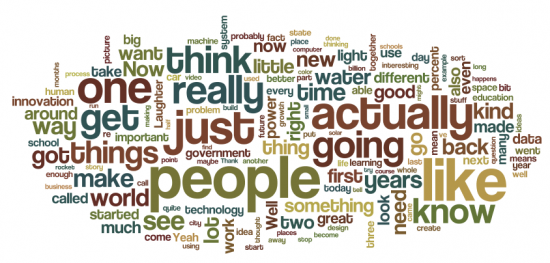Speaking of 2013: The Language of Innovation

As 2013 comes to a close, lists of the “Best of 2013” fill our news feeds and dominate the covers of magazines in the check-out line. This year, CNN’s Ten Thinkers of 2013 caught our attention. CNN picked ten innovative people in the fields of science and technology that are considered “visionaries whose ideas are shaping our future.” The list includes people like Elon Musk – CEO of Tesla Motors and SpaceX; Andrew Ng – co-founder of the online learning site Coursera; and Mary Lou Jepsen – a pioneer in the field of computer displays who has worked on projects such as Google Glass and the driverless car. This choice of innovators got us thinking:
How do innovative people communicate? Is there something special about the language they use that helps them to stand out?
To crack the code of innovative language, we decided to expand CNN’s list by searching for TED speakers who fall under the “innovative” category, dating back to 2010. We ran speeches, interviews and presentations of 27 innovators through our Natural Language Processing and Linguistic Mapping tools and compared them to our proprietary database comprised of more than 24,000 communicators using over 160 million words.
What we expected: We anticipated that the language of these pioneering speakers would be optimistic, complex and focused on the future.
What we found: Our expectations were wrong. The language of the innovative speakers was no more optimistic than the politicians, bankers, teachers and the averages of our database. Their language did not reveal an above-average use of the future tense, nor was it overly confident.
The innovators spoke primarily in the present tense (40% more than average), used more (26%) persuasive language than average, used more stories (21% more than average) to get their point across, and used 20% more accessible and clear language.
To make sense of these results, we researched what it means to be an innovator. An innovator is someone who is the first to introduce something new and better than before. Entrepreneur.com describes innovators as “…change agents who are relentless in making things happen and bringing ideas to execution.” Innovators have big ideas. They dream big and are constantly thinking about the future. But what makes them truly innovative is that they are able to make their dreams become reality. They take big ideas and turn them into tangible results right here and now. They speak clearly, use stories to help make their big ideas understandable, and persuade audiences that their ideas will work.
As we all prepare for the New Year by making our laundry list of resolutions and goals, we can learn a thing or two from these innovators. Many of us have big ideas that stay ideas forever. But to reach our goals and, yes, to be truly innovative, we have to turn those ideas into realities. We can start by focusing on our communication. By speaking in the present tense, using stories to explain our ideas, using clear and persuasive language, we can enlist others in our big ideas and begin to make them real.